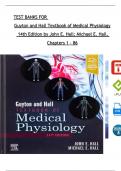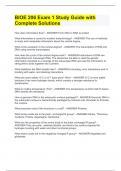TEST BANKS FOR
Guyton and Hall Textbook of Medical Physiology
14th Edition by John E. Hall; Michael E. Hall,
Chapters 1 - 86
,Guyton and Hall Textbook of Medical Physiology 14th Edition Test Bank by John E. Hall, Michael E. Hall
Table of Contents
Unit I. Introduction to Physiology: The Cell and General Physiology
Chapter 1. Functional Organization of the Human Body and Control of the “Internal Environment”
Chapter 2. The Cell and Its Functions
Chapter 3. Genetic Control of Protein Synthesis, Cell Function, and Cell Reproduction
Unit II. Membrane Physiology, Nerve, and Muscle
Chapter 4. Transport of Substances Through Cell Membranes
Chapter 5. Membrane Potentials and Action Potentials
Chapter 6. Contraction of Skeletal Muscle
Chapter 7. Excitation of Skeletal Muscle: Neuromuscular Transmission and Excitation-Contraction
Coupling
Chapter 8. Excitation and Contraction of Smooth Muscle
Unit III. The Heart
Chapter 9. Cardiac Muscle; The Heart as a Pump and Function of the Heart Valves
Chapter 10. Rhythmical Excitation of the Heart
Chapter 11. Fundamentals of Electrocardiography
Chapter 12. Electrocardiographic Interpretation of Cardiac Muscle and Coronary Blood Flow
Abnormalities: Vectorial Analysis
Chapter 13. Cardiac Arrhythmias and Their Electrocardiographic Interpretation
Unit IV. The Circulation
Chapter 14. Overview of the Circulation: Pressure, Flow, and Resistance
Chapter 15. Vascular Distensibility and Functions of the Arterial and Venous Systems
Chapter 16. The Microcirculation and Lymphatic System: Capillary Fluid Exchange, Interstitial Fluid,
and Lymph Flow
Chapter 17. Local and Humoral Control of Tissue Blood Flow
Chapter 18. Nervous Regulation of the Circulation and Rapid Control of Arterial Pressure
Chapter 19. Role of the Kidneys in Long-Term Control of Arterial Pressure and in Hypertension: The
Integrated System for Arterial Pressure Regulation
Chapter 20. Cardiac Output, Venous Return, and Their Regulation
Chapter 21. Muscle Blood Flow and Cardiac Output During Exercise; the Coronary Circulation and
Ischemic Heart Disease
Chapter 22. Cardiac Failure
Chapter 23. Heart Valves and Heart Sounds; Valvular and Congenital Heart Defects
Chapter 24. Circulatory Shock and Its Treatment
Unit V. The Body Fluids and Kidneys
Chapter 25. Regulation of Body Fluid Compartments: Extracellular and Intracellular Fluids; Edema
Chapter 26. The Urinary System: Functional Anatomy and Urine Formation by the Kidneys
Chapter 27. Glomerular Filtration, Renal Blood Flow, and Their Control
Chapter 28. Renal Tubular Reabsorption and Secretion
,Chapter 29. Urine Concentration and Dilution; Regulation of Extracellular Fluid Osmolarity and
Sodium Concentration
Chapter 30. Renal Regulation of Potassium, Calcium, Phosphate, and Magnesium; Integration of Renal
Mechanisms for Control of Blood Volume and Extracellular Fluid Volume
Chapter 31. Acid–Base Regulation
Chapter 32. Diuretics and Kidney Diseases
Unit VI. Blood Cells, Immunity, and Blood Coagulation
Chapter 33. Red Blood Cells, Anemia, and Polycythemia
Chapter 34. Resistance of the Body to Infection: I. Leukocytes, Granulocytes, the Monocyte-
Macrophage System, and Inflammation
Chapter 35. Resistance of the Body to Infection: II. Immunity and Allergy
Chapter 36. Blood Types; Transfusion; and Tissue and Organ Transplantation
Chapter 37. Hemostasis and Blood Coagulation
Unit VII. Respiration
Chapter 38. Pulmonary Ventilation
Chapter 39. Pulmonary Circulation, Pulmonary Edema, and Pleural Fluid
Chapter 40. Principles of Gas Exchange; Diffusion of Oxygen and Carbon Dioxide Through the
Respiratory Membrane
Chapter 41. Transport of Oxygen and Carbon Dioxide in Blood and Tissue Fluids
Chapter 42. Regulation of Respiration
Chapter 43. Respiratory Insufficiency—Pathophysiology, Diagnosis, Oxygen Therapy
Unit VIII. Aviation, Space, and Deep-Sea Diving Physiology
Chapter 44. Aviation, High Altitude, and Space Physiology
Chapter 45. Physiology of Deep-Sea Diving and Other Hyperbaric Conditions
Unit IX. The Nervous System: A. General Principles and Sensory Physiology
Chapter 46. Organization of the Nervous System, Basic Functions of Synapses, and Neurotransmitters
Chapter 47. Sensory Receptors, Neuronal Circuits for Processing Information
Chapter 48. Somatic Sensations: I. General Organization, Tactile and Position Senses
Chapter 49. Somatic Sensations: II. Pain, Headache, and Thermal Sensations
Unit X. The Nervous System: B. The Special Senses
Chapter 50. The Eye: I. Optics of Vision
Chapter 51. The Eye: II. Receptor and Neural Function of the Retina
Chapter 52. The Eye: III. Central Neurophysiology of Vision
Chapter 53. The Sense of Hearing
Chapter 54. The Chemical Senses—Taste and Smell
Unit XI. The Nervous System: C. Motor and Integrative Neurophysiology
Chapter 55. Spinal Cord Motor Functions; the Cord Reflexes
Chapter 56. Cortical and Brain Stem Control of Motor Function
Chapter 57. Cerebellum and Basal Ganglia Contributions to Overall Motor Control
Chapter 58. Cerebral Cortex, Intellectual Functions of the Brain, Learning, and Memory
,Chapter 59. The Limbic System and the Hypothalamus—Behavioral and Motivational Mechanisms of
the Brain
Chapter 60. States of Brain Activity—Sleep, Brain Waves, Epilepsy, Psychoses, and Dementia
Chapter 61. The Autonomic Nervous System and the Adrenal Medulla
Chapter 62. Cerebral Blood Flow, Cerebrospinal Fluid, and Brain Metabolism
Unit XII. Gastrointestinal Physiology
Chapter 63. General Principles of Gastrointestinal Function—Motility, Nervous Control, and Blood
Circulation
Chapter 64. Propulsion and Mixing of Food in the Alimentary Tract
Chapter 65. Secretory Functions of the Alimentary Tract
Chapter 66. Digestion and Absorption in the Gastrointestinal Tract
Chapter 67. Physiology of Gastrointestinal Disorders
Unit XIII. Metabolism and Temperature Regulation
Chapter 68. Metabolism of Carbohydrates and Formation of Adenosine Triphosphate
Chapter 69. Lipid Metabolism
Chapter 70. Protein Metabolism
Chapter 71. The Liver
Chapter 72. Dietary Balances; Regulation of Feeding; Obesity and Starvation; Vitamins and Minerals
Chapter 73. Energetics and Metabolic Rate
Chapter 74. Body Temperature Regulation and Fever
Unit XIV. Endocrinology and Reproduction
Chapter 75. Introduction to Endocrinology
Chapter 76. Pituitary Hormones and Their Control by the Hypothalamus
Chapter 77. Thyroid Metabolic Hormones
Chapter 78. Adrenocortical Hormones
Chapter 79. Insulin, Glucagon, and Diabetes Mellitus
Chapter 80. Parathyroid Hormone, Calcitonin, Calcium and Phosphate Metabolism, Vitamin D, Bone,
and Teeth
Chapter 81. Reproductive and Hormonal Functions of the Male (and Function of the Pineal Gland)
Chapter 82. Female Physiology Before Pregnancy and Female Hormones
Chapter 83. Pregnancy and Lactation
Chapter 84. Fetal and Neonatal Physiology
Unit XV. Sports Physiology
Chapter 85. Sports Physiology
,Chapter 1. Functional Organization of the Human Body and Control of the
“Internal Environment”
Test Bank
1. The most abundant type of cell in the human body is which of the following?
A. Neuron
B. Epithelial cell
C. Red blood cell
D. White blood cell
E. Vascular smooth muscle cell
F. Skeletal muscle cell
ANSWER: C
2. The most abundant substance in the human body and the approximate percentage ofthat
substance in the body is which of the following?
A. Protein, 30%
B. Protein, 60%
C. Water, 30%
D. Water, 60%
E. Carbohydrate, 30%
F. Carbohydrate, 60%
ANSWER: D
3. A large volume of blood is transfused to a person whose baroreceptor blood pressure
control system is not functioning and arterial blood pressure rises from the normal level
of 100 to 160 mm Hg. If the same volume of blood is infused into the same person when
the baroreceptor system is functioning and this time the arterial pressure increases from
the normal level from 100 mm Hg up to 120 mm Hg, calculate the gain of the
baroreceptor system in this person.
A. -3
B. -2
C. -1
D. 0
, E. +1
F. +2
G. +3
ANSWER: B
4. Which of the following substances has the highest extracellular fluid to intracellular
fluid concentration ratio for most mammalian cells?
A. Sodium ions
B. Potassium ions
C. Carbon dioxide
D. Glucose
E. Protein
ANSWER: A
5. Exchange of substances between the cardiovascular system and the interstitial fluid
occurs mainly in which of the following?
A. Arteries
B. Arterioles
C. Capillaries
D. Venules
E. Veins
ANSWER:
C
6. Which of the following is the approximate distance from the capillaries to most cellsof
the body?
A. Less than 50 angstroms
B. Less than 50 microns
C. Less than 50 millimeters
D. Less than 100 angstroms
E. Less than 100 microns
F. Less than 100 millimeters
ANSWER: A
7. When a person is at rest, how much time is required for the blood in the circulation to
traverse the entire circulatory circuit?
A. 1 second
B. 1 minute
C. 3 minutes
D. 4 minutes
E. 5 minutes
ANSWER: B
,8. feedback is often referred to as a "vicious cycle" because it leads to
instability and sometimes death.
A. Postitive, progressive
B. Positive, diminished
C. Negative, progressive
D. Negative, diminished
E. Adaptive, progressive
ANSWER: A
9. Which of the following is an example of positive feedback in the body?
A. Clotting of blood
B. Return of blood pressure toward normal after a hemorrhage
C. Increased respiration rate caused by accumulation of carbon dioxide in the blood
D. Decreased sympathetic nervous system activity that occurs in response to increased
blood pressure
ANSWER: A
Chapter 2. The Cell and Its Functions
Test Bank
Refer to the following list to answer questions 1-3:
A. Nucleolus
B. Nucleus
C. Agranular endoplasmic reticulum
D. Granular endoplasmic reticulum
E. Golgi apparatus
F. Endosomes
G. Peroxisomes
H. Lysosomes
I. Cytosol
Identify the cellular location for each of the following steps involved in the synthesis and
packaging of a secreted protein.
Initiation of translation.
ANSWER: I
,Protein sorting and packaging.
ANSWER: E
Gene transcription.
ANSWER: B
4. Which of the following is true for both pinocytosis and phagocytosis?
A. Involves the recruitment of actin filaments
B. Occurs spontaneously and non-selectively
C. Permits the uptake of bacterium into the cytosol
D. Is only observed in macrophages and neutrophils
E. Does not require ATP
ANSWER: A
5. The cell membrane is LEAST permeable to which of the following?
A. Sodium
B. Oxygen
C. Ethanol
D. Carbon Dioxide
E. Water
ANSWER: A
6. The term “glycocalyx” refers to:
A. The negatively charged carbohydrate chains that protrude into the cytosol from
glycolipids and integral glycoproteins
B. The negatively charged carbohydrate layer on the outer cell surface
C. The layer of anions aligned on the cytosolic surface of the plasma membrane
D. The large glycogen stores found in “fast” muscles
E. A mechanism of cell-cell attachment
ANSWER: B
7. Proteins are sorted for their delivery to lysosomes, secretory vesicles and the plasma
membrane in the:
A. Golgi apparatus
B. smooth endoplasmic reticulum
C. nucleus
D. endocytotic vesicle
ANSWER: A
8. Ubiquinone, an electron acceptor in the electron transport chain (oxidative
phosphorylation), is found in the:
, A. Inner mitochondrial membrane
B. Mitochondrial matrix
C. Outer mitochondrial membrane
D. Nucleus
ANSWER: A
9. The citric acid cycle or Kreb’s cycle, takes place in the:
A. Mitochondrial matrix
B. Inner mitochondrial membrane
C. Outer mitochondrial membrane
D. Inner mitochondrial space
ANSWER: A
10. Which of the following processes is NOT ATP-dependent?
A. Ciliary movement
B. Positive chemotaxis
C. Movement of carbon dioxide across a lipid bilayer
D. Endocytosis
E. Smooth muscle contraction
ANSWER: C
11. This cytoskeletal element plays a role in certain forms of cell movement and is an
essential component of the mitotic spindle:
A. Phospholipids
B. Glycocalyx
C. F-actin
D. Microtubules
E. Clathrin
ANSWER: D
12. Lipid synthesis occurs in the:
A. Trans-Golgi network
B. Granular or “rough” endoplasmic reticulum
C. Agranular or “smooth” endoplasmic reticulum
D. Nucleus
E. Lysosome
ANSWER: C
13. This cytoskeletal element plays a role in certain forms of cell movement and is an
essential component of the mitotic spindle:
A. Phospholipids
B. Glycocalyx
, C. F-actin
D. Microtubules
E. Clathrin
ANSWER: D
14. The abnormal cleavage of mannose residues during the post-translational processing of
glycoproteins has been shown to result in the development of a lupus-like autoimmune
disease in mice. The abnormal cleavage is due to a mutation of the enzyme -mannosidase
II.
Based on your understanding of the processing of membrane proteins, you would predict
this enzyme to be localized to the:
A. Nucleus
B. Cytosol
C. Golgi apparatus
D. Lysosomes
E. Peroxisomes
ANSWER: C
15. The observation that abnormal cleavage of mannose residues from glycoproteins
causes an autoimmune disease in mice is most consistent with the role of which of the
following structures in the normal immune response?
A. Cytoskeleton
B. Glycocalyx
C. Peroxisomes
D. Lysosomes
E. Microtubules
ANSWER: B
16. A pure phospholipid bilayer is most permeable to:
A. Sodium
B. Calcium
C. Chloride
D. Water
E. Oxygen
ANSWER: E
Chapter 3. Genetic Control of Protein Synthesis, cell function, and cell
reproduction





